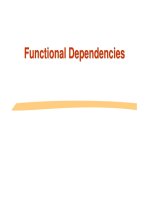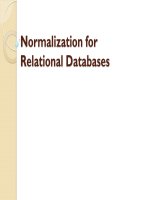Distributed Database Management Systems: Lecture 9
Bạn đang xem bản rút gọn của tài liệu. Xem và tải ngay bản đầy đủ của tài liệu tại đây (202.98 KB, 27 trang )
Distributed Database
Management Systems
Lecture 09
In the previous lecture
• Derived Relational
Algebra Ops…..
• Relational Calculus
• Computer Networks
In this Lecture
• Networks continued
• DDBMS Architecture
Scale
• Local Area Network
• Metropolitan Area Network
• Wide Area Network
WANs
• Used Inter-City, country or
even continental
• Gives low bandwidth, high
latency
• Can be Broadcast and Point
to Point
• In Point to Point
–Circuit Switching
–Packet Switching
Circuit Switching
• Dedicated link b/w Sender
Receiver
• Maintained during
conversation
Packet Switching
• Message into Packets
• May take different
routes
• Need to be sorted
Advantages of Packet Switching
• Better Link Utilization
• Bursty Nature of
communication
• Parallel transmission
LANs
• Small geographical area (usu.
2 km)
• High bandwidth
• Low latency
• Technology
– Mainly Ethernet, now
100/1000Mbps
MANs
• Between LAN and WAN
• Cover city or portion
• Larger LANs
Protocol Standards
Set of rules and formats
for exchanging data,
arranged into layers
called protocol suite/
stack.
• WAN faces max
heterogeneity
• Needs protocols
• ISO/OSI
ISO/OSI Architecture
• Network built in seven
layers
• Interfaces for passing
information b/w layers
• Protocols between
corresponding layers
at different sites
• Lower three layers
form Comm. subnet
TCP/IP Architecture
• Another popular
Architecture
• Five layers
• IEEE Committee 802
Distributed DBMS
Architecture
Architecture of a
systems defines its
structure
Sheth, A. P., Larson, J. A., ‘
Federated Database
Systems for Managing
Distributed Heterogeneous,
and Autonomous
Databases’, ACM
Computing Surveys, 22, No.
3, p(183-236), Sep., 90
• Three major (idealized)
architectures of DDBMS
discussed
–Peer to peer
–Client/Server
–Multidatabase
DBMS Standardization
A conceptual framework
to divide standardization
work into manageable
pieces
• Component-based
• Function-based
• Data-based









